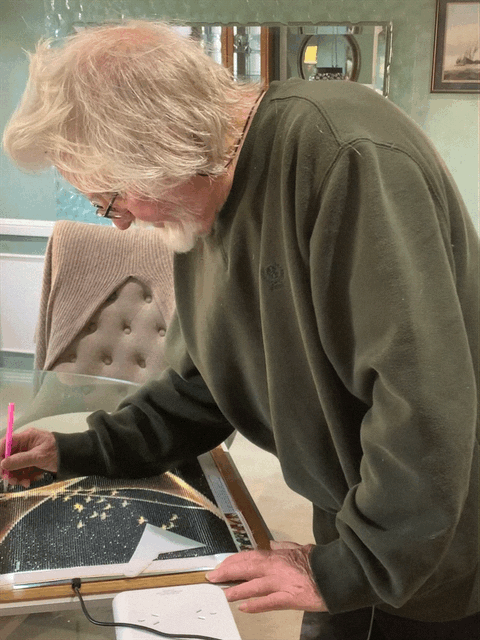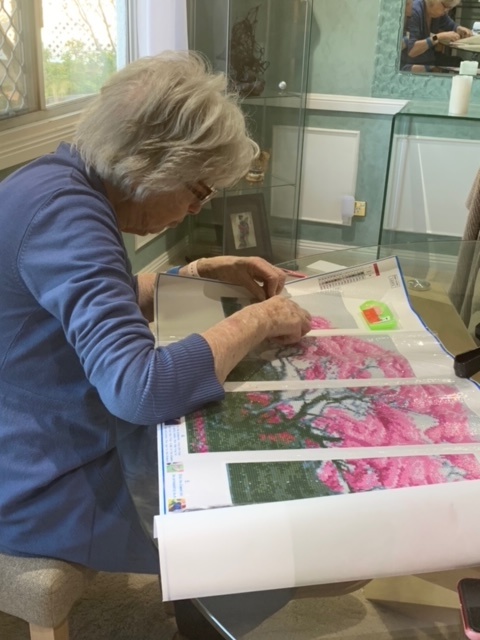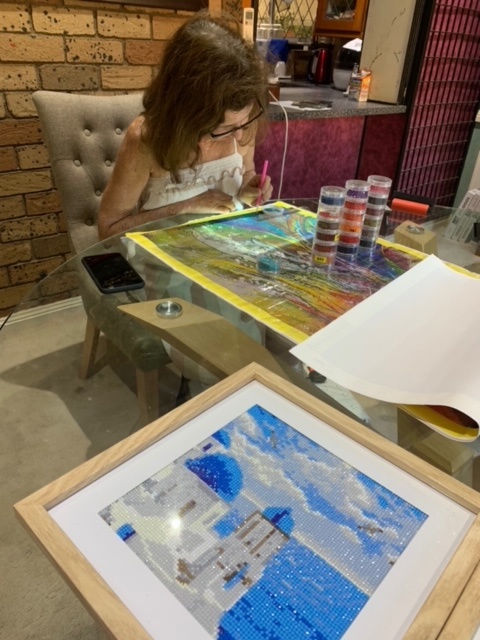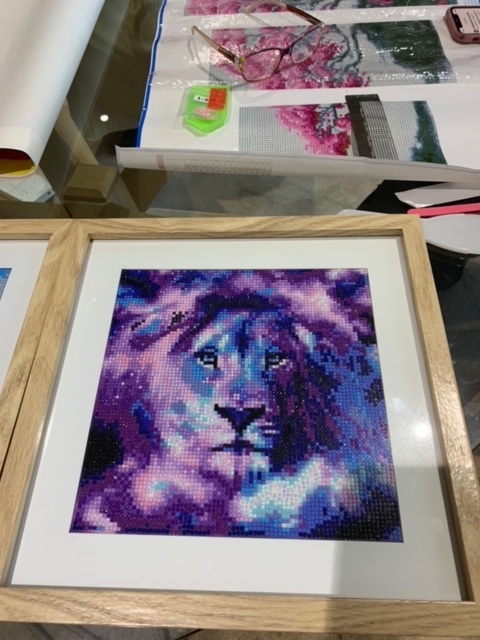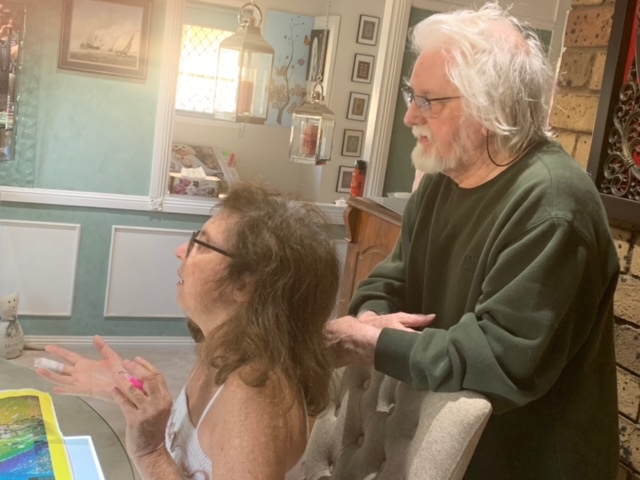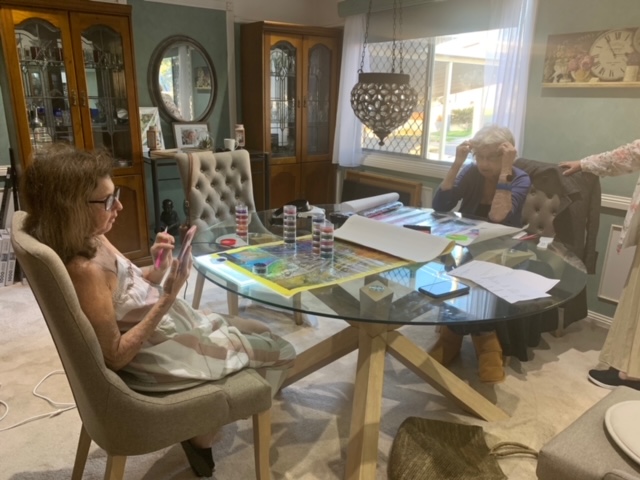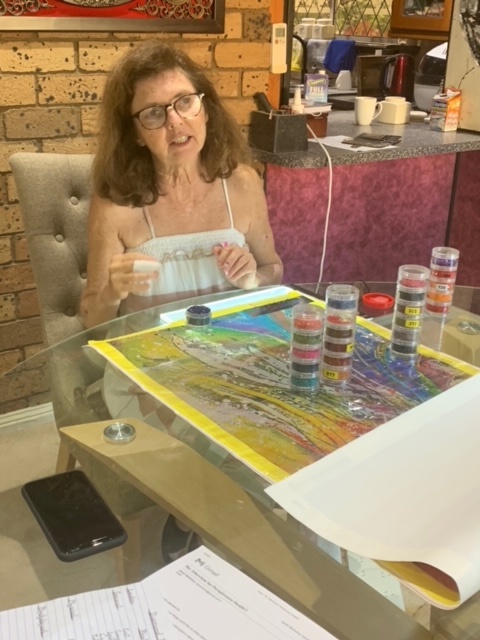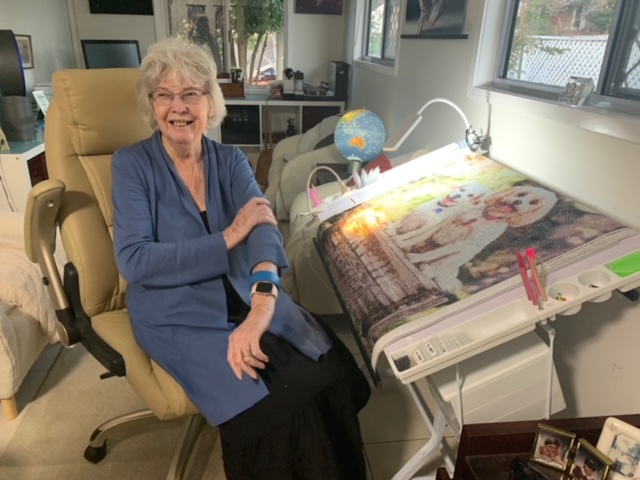- Name
- The Watford Family
- Expertise/Specialty
- The Watford family are based in Brisbane, Australia. Colin and Jean are in their eighties and have four adult children, seven grandchildren, one grandson, two step grandchildren, four step great grandchildren, four step great great grandchildren and two magnificent cats! Now that is quite a dynasty! In the last nine months, Jean and Colin, who are both retired, and their daughter, Karen, have taken up diamond art, each with a different way of approaching it. They always have a painting they're creating.
- Tell us a little about what's involved in diamond art.
Diamond art is a hybrid craft form that's a mix between painting-by-numbers, embroidery and jigsaw puzzles. How on earth is that possible? Well, it's a relatively new form of craft whereby you follow a pattern of symbols on a grid to place different coloured 'diamond' pieces, called drills, into a set position. It's great fun, and the whole family can get involved, choosing pieces of art they like most. It's a versatile hobby that can be enjoyed by anyone, from teenagers to grandparents. It can be a solo pastime you do to switch off and create, or a social afternoon or evening with friends or family members working together around the dining or rumpus room table.
There are many different kinds and sizes of pictures you can get to do diamond art with. They could be artworks, photographs, cartoons, portraits, abstracts, landscapes - you name it. You can even take your own photograph and have it turned it into diamond art. You can get a sense of the range of designs available from the photographs at the end.
These days, there are more than just canvas options to work on. You can do key rings, bags, masks, bookmarks, decorations, mirrors, tissue boxes and lampshades!
- How did you initially get involved in diamond art?
Jean: Our son and daughter-in-law gave me a basic kit for Christmas 2020. Who would have thought that nine months later, not only me, but my husband Colin and daughter Karen, would all be so involved in it. They watched me doing it and decided to get their own sets. I so enjoy it. I used to do embroidery and that has helped me a lot with sorting out and applying the colours. There are about 450 drill colours available and they're the same as embroidery ones.
Colin: I'm an artist and already have a good eye for detail. That's what attracted me to diamond art - you have the grand image, and bit by bit you create it. The details don't appear to matter as you're doing it though you know they'll get you to the result you want, as you build it up over time.
- How do you go about working on your diamond art?
Karen: It's an absorbing, low cost leisure activity, similar to jigsaw puzzles. With a jigsaw puzzle, when it's over, it's over and you generally won't touch it again for a long time. With diamond art, you end up with a completed piece of art that you can seal, frame and keep, or give away as a gift. I like that it can be a portable form of craft if you wish. If I'm visiting my parents, I can roll the piece up and put it in a poster container, and take all the drill pots that I've sorted with me. Some days we sit together in our own space, engaged in our own diamond art piece. Unlike reading, you can talk, watch TV or listen to music as you're doing it.
Colin: When you buy a kit, you get everything you need to create it, though you can get some additional tools if you decide to do more than one. You may well become addicted like the three of us! You receive the canvas, a rolled piece on which the grid template is printed with symbols that represent different colours. You get all the coloured drills you need, a 'pen' and a wax pad. There are no liquids so no spills to clean up. Your kit will have either round or square drills and, after trying both, you'll find you probably have a preference for one or the other. I prefer the round. You need a bit of space, such as a place at a large table, as you need to spread out the piece and have room for your tools.
You can determine how you want to go about complete the canvas. You may work with one particular colour at a time or you might focus on a small patch at a time, using all the colours needed in that area. There is no right or wrong way. You can also use a roller to press them down securely, a ruler to align the drills which makes the painting neater, set up containers to keep your drills organised, and use a LED light board to distinguish the drills more easily. These are optional and more for 'serial' diamond artists.
Jean: I have bought an angled desk, especially for diamond art, that I work on. It keeps all my drills and tools in one place and I don't have to keep packing them up. Whenever I want to, I can sit down and do a bit of art without it having to be a big decision to get my materials out. It makes such a difference to me.
- What qualities has it developed or reinforced in you?
Colin: It helps you develop patience, concentration and determination. It requires your focus, as you do have to pay attention, yet is also relaxing as it takes your mind off everyday matters.
Jean: If you're stressed, when you do diamond art a calmness comes over you. Your mind switches off from your concern and all you think about is the creation before you.
Karen: I love the quietness and peacefulness. I lose myself in it. It's good for anxiety, depression and even ADHD. Kids who are running around one minute can sit down and concentrate over their diamond art. It's amazing.
- Do you have any interesting stories you can share?
Jean: At the moment I'm working on my first customised diamond art - it's a gift for my other daughter. I sent a photo of their dogs to a diamond art studio. They recommended a size (larger is better for customised pieces so that the image isn't pixellated), printed a canvas, determined how many and what coloured drills I needed and then packed it all off to me. It took 78,000 drills! I'm very pleased with it.
Karen: There's quite a community out there globally. We connect on various facebook groups and share ideas, advice and techniques. It's a nice way to connect up with people. Someone might want particular coloured drills - each drill colour has a specific number it can be identified as. Mum and dad give me their left over drills and I keep all my old drills when I finish a piece or art. I have 280 colours. It's nice to be able to post them off to people around the world to help them out. I don't charge them for it and just ask that they pay if forward to others if the opportunity arises.
- What are some of the personal and health benefits you've experienced?
Colin: It is very relaxing. You can get into a state of flow, where the time passes without you noticing. It requires some amount of coordination, as you work out which way of working suits you. You're constantly moving your arm, hands, head and abdomen, so it stops you being sedentary. Sometimes I like to stand up while I'm doing some pieces, while others might prefer to sit.
Jean: I like to keep busy so for me it's a great way to relax yet still be creating something. It can keep your blood pressure under control and is good for your mental health generally. I feel a sense of satisfaction as I see the artwork getting completed. The reward of seeing your painting at the end is wonderful. It usually takes me two to three months to finish a piece. It's a bit like wanting to finish reading a good book - you're satisfied yet also wish it wasn't over!
- What advice would you give to someone interested in starting diamond art?
Karen: Diamond art kits can be purchased at retail outlets such as craft or bargain shops, or ordered online. Delivery will usually come within seven to ten working days. The pictures are packaged as a complete kit. The tiny multi-coloured drills are either square or round in shape, and give the appearance of coloured jewels... leading to the name, diamond art. One kit can cost as little as $5 or as much as $100. Shop around as there's an infinite range of paintings available under $25.
I'd recommend starting on a small sized painting and work up to larger ones as you get more skilled. You can get 'partial' canvases, where the image is diamond art and the background is not - they are good for beginners learning the ropes or kids.
.
Join a diamond art facebook group and post lots of questions - we're all happy to help you out!
